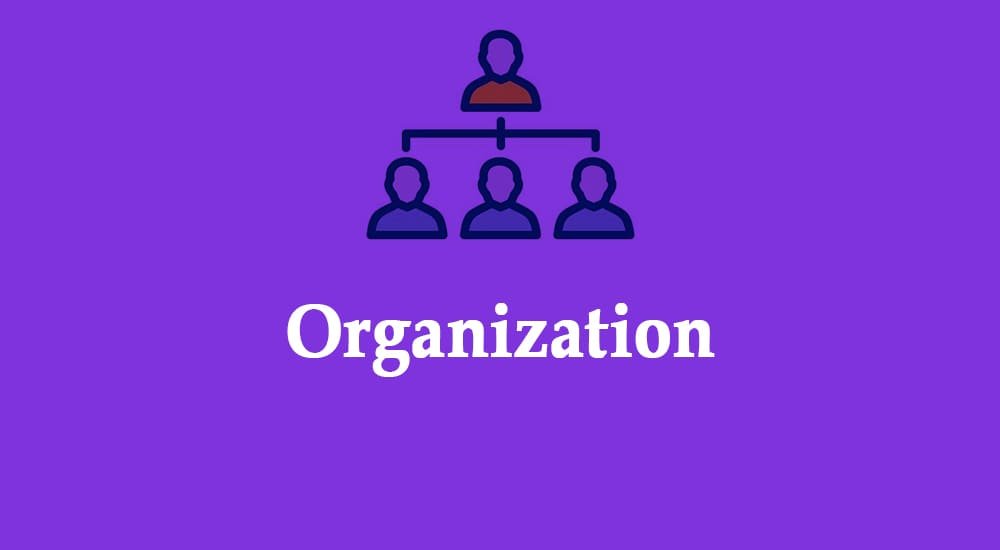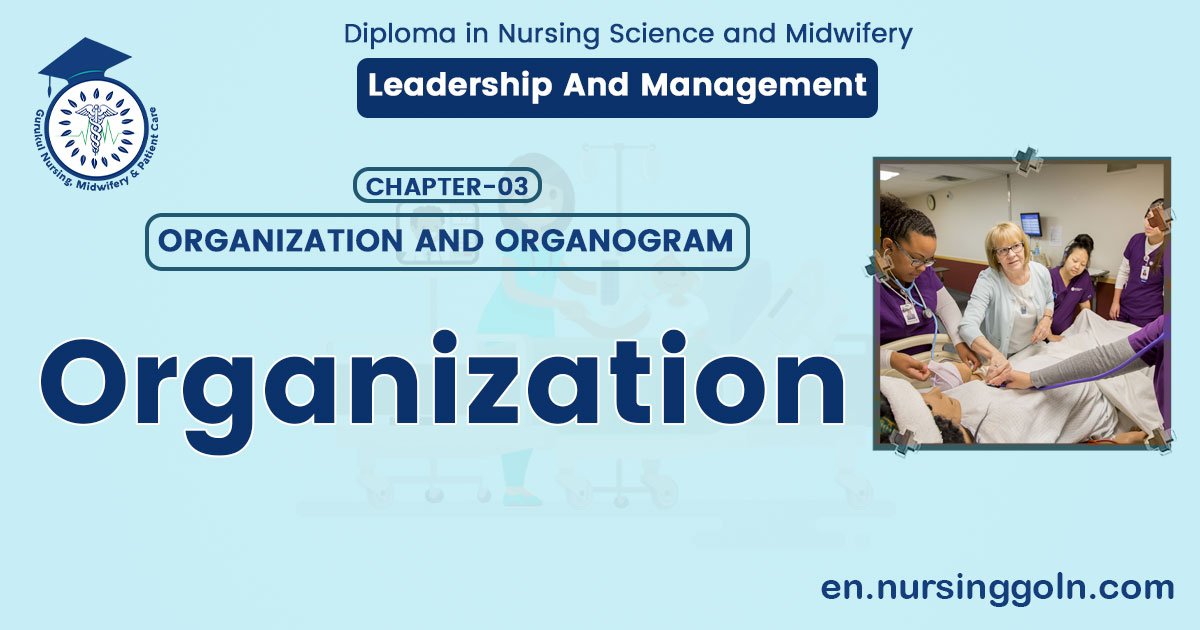Definition of Organization – This book covers the entire syllabus of “Leadership & Management” prescribed by the BNMC for Diploma in Nursing Science & Midwifery Students.
We tried to accommodate latest information and topics. This book is examination friendly setup according to the teachers’ lectures and examination’s questions. At the end of the book previous university questions are given. We hope in touch with the pook students’ knowledge will be upgraded and flourished. The unique way of presentation may make your reading of the book a pleasurable experience.

Definition of Organization
The term ‘organization’ is derived from the word ‘organism’, which masa struture of bo divided into parts that are held together by fabric of relationship as one organic whole Organization is the act of organizing or the state of being organized. It also refers to an organi structure or whole. The term ‘organization’ suggests a functional group working together for achieving common purposes/objectives.
Organizing is one of the basic functions of management that involves developing an organizational structure and allocating human resources to ensure the accomplishment objectives. Organizing at the level of the organization involves deciding how hest to departmentalize or cluster jobs into departments to effectively coordinate effort. So in the broad sense, organizing refers to the relationship between the various factors present in an organization.
The concise Oxford Dictionary defines, the word to organize as to frame and put into the working order’. Organizing is a function of management, while organization refers to a group of persons who have come together to achieve some common objectives. Organizing refers to the way in which the work of a group of people is arranged and distributed among group members.
The purpose is to create a framework for the performance the activities of an organization in a systematic manner. The process of organizing refers to identifying and grouping of activities to be performed, defining and delegating authority, casting responsibility and establishing relationships to enable people to work together effectively in accomplishing objectives.
Organizing involves integration of resources in order to accomplish the objectives. It also means arranging the ways and means for the execution of a plan. It is the creation of administrative setup for the execution of the plan. It suggests the framework within which the management functions.
Definition of Organization:
According to JD Mooney
“Organization is the form of every human association for the attainment of common purpose and the process of relating specific duties or function in a whole”
According to J William Schulze
“An organization is a combination of the necessary human beings, materials, tools, equipment. working space and appurtenance brought together in systemic and effective coordination to accomplish some desired objects”.
According to Luther Gullick
“Organization is the formal structure of authority through which work subdivisions are arranged, defined and coordinated for the defined objective”.
According to Chester I Bernard
Organization is a system of cooperative activities of two or more persons
According to Pfiffiner
Organization consists of relationship of the individual to individuals and groups to groups, which are related as to bring about an orderly division of labor
Importance of Organization:
1. Organization is fundamental for implementing plans.
2. It gives utmost importance to the optimum utilization of the enterprise resources, namely man, money material, and machine.
3. It provides sufficient scope for the individuals to exhibit their creative skill thus enhance
communication and improve relationship among employees.
4. It ensures that there is no disruption of work due to no availability of men, money, materials, and machines. Thus improves coordination for better performance.
Another Answer
1. Organization increases managerial efficiency in a number of ways. It provides the structure within which the functions of administration are performed:
- It avoids delay, duplication or confusion in performance and remove friction or rivalry among personnel
- Analysis of objectives of institution provides all pertinent activities
- Activities in turn are allocated to particular individuals
- Assignment of fixed duties helps to add certainty and promptness in their work.
2. Organization ensures an optimum use of human efforts through specialization and also makes use of all resources, determines needs for innovative and new technologies in terms of cost-effectiveness and accomplish objectives:
- Details of job specification helps for right persons are placed in the right position on the basis of their knowledge, skill and experience.
3. Organization places a proportionate and balanced emphasis on various activities:
- Money and efforts can be spent proportionately with the importance of activities.
4. Organization facilitates coordination in the enterprises:
- Different departments and section, positions and job functions are welded together by structural relationship of the organization.
5. Organization provides scope for training and developing managers. Encourages individual’s growth and development of personnel according to individual potentials through job enrichment, training and participation.
6. Organization helps to consolidate growth and expansion of the enterprise/institution. It helps in growth and development of the establishment, in planning for need-based change through appropriate division and allotment of works.
7. Organization invites creative and innovative ideas by working through adopting human
relations approach.
8. Organization prevents the growth of laggards, wirepullers, intriguers or other forms of corrupters.
9. Unsound organization becomes the breeding ground of corruption, dishonesty and such odd things.

Nature of an Organization:
There are some common features of organization through which a clear, idea about its nature can be obtained. These are indicated below:
| Process: | Organization is a process of defining, arranging and grouping the activities of an enterprise and establishing the authority relationships among the persons performing these activities. It is the framework within which people associate for the attainment of an objective. The framework provides the means for assigning activities to various parts and identifying the relative authorities and responsibilities of those parts. In simple term, organization is the process by which the chief executive, as a leader, groups his men in order to get the work done. |
| Structure: | The function of organizing is the creation of a structural framework of duties and responsibilities to be performed by a group of people for the attainment of the objectives of the concern. The organization structure consists of a series of relationships at all levels of authority. An organization as a structure contains an “identifiable group of people contributing their efforts towards the attainment of goals,” |
| Dividing and Grouping the Activities: | Organizing means the way in which the parts of an enterprise are put into working order. In doing such, it calls for the determination of parts and integration of one complete whole on the other. In fact, organization is a process of dividing and combining the activities of an enterprise. Activities of an enterprise are required to be distributed between the departments, units or sections as well as between the persons for securing the benefits of division of labour and specialization, and are to be integrated or combined for giving them a commonness of purpose. |
| Accomplishment of Goals or Objectives: | An organization structure has no meaning or purpose unless it is built around certain clear-cut goals or objectives. In fact, an organization structure is built-up precisely because it is the ideal way of making a rational pursuit of objectives. |
| Authority- Responsibility Relationship: | An organization structure consists of various positions arranged in a hierarchy with a clear definition of the authority and responsibility associated with each of these. An enterprise cannot serve the specific purposes or goals unless some positions are placed above others and given authority to bind them by their decisions. |
| Humah and Material Aspects: | Organization deals with the human and material factors in business. Human element is the most important element in an organization. To accomplish the task of building up a sound organization, it is essential to prepare an outline of the organization which is logical and simple. The manager should then try to fit in suitable men. |
Theories of Organization
Evolution of management thought can be divided into three broad classifications as given under:
1. The classical theory of management: It can be identified into three streams of thoughts..
These are:
a) Bureaucratic model introduced by Max Webber,
b) Scientific management introduced by Taylor FW
c) Process Management by Henry Fayol.
2. Neoclassical theory: It consists of two streams of thought:
a) Human relations propounded by Elton Mayo and Roethlisberger.
b) Behavioral sciences movements introduced by Maslow A, McGregor D, Herzberg F and Vroom VH.
3. The modern management: It consists of three streams of thought:
a) Quantitative approach to management.
b) Systems approach to management by Kennetht Boulding, Johnson, Cast, Rosenzweig, Churchman CW, etc.
e) Contingency approach by Johnson Woodward Fiedler, Lorsch and Lawrence
Each of these management thought evolution have been discussed as below.

Classical Theory
The systematic study of management has a separate field of endeavor. It was Robert Owen and Charles Babbage who gave serious thought to the problems of management. It was Max Webber who introduced the bureaucratic model. It was the emergence of first systematic management theory.
Robert Owen
Robert Owen was a scientific manager of his time and was greatly admitted for giving human by treatment to the workers. He worked throughout his life for living up of a spirit of cooperation between the workers and the management. He is noted for the development of personal relations; improved conditions of employment, reform of working conditions.
Charles Babbage
Charles Babbage, the Cambridge professor of mathematics propounded that methods of science and mathematics could be applied to the operation of factories. He advocated that managers should take decisions through rigid investigation; to divide work into physical and mental efforts; to determine the cost for every process and to pay a bonus to the workers in proportion to their efficiency. His contributions of significance are:
- Cost accounting.
- The Babbage calculating machine.
Management has always faced with the problem of selecting various concepts from all these areas and integrating them in the process of decisions-making regarding the major policies and day-to-day operations.
During the 19th century, the efforts of managers had been to cope up with their environments and to organize and operate in those environments. During the first one third of the century the attempt was to rationalize the way work was done.
The emphasis was to increase the productivity of the goods and services produced. After the World War II there was a considerable change in the working conditions of the working men. The working men began to demand that work environment should meet part of their social needs in addition to the basic needs.
Then emerged the phase of human relations and the focus was on man’s social needs and the way of meeting them to increase productivity. But, in late 1960s it became clear that knowledge on which the management is based is no longer adequate even for the basic areas. There emerged needs fornew knowledge particularly referred to productivity organization structure, job design and management of people.
Following are the nine important concepts highlighting the present concepts of management:
1. Scientific management, a key to productivity,
2. Decentralization for quicker decisions and better control.
3. Personnel management as a means of selecting people into organization.
4. Manager’s development programs to train managers how to meet the needs of tomorrow.
5. Management accounting a foundation for managerial decision.
6. Marketing.
7. Long-range planning.
8. Role of operational research in management decision-making.
9. Financial management for effective utilization of money resources in the organization.
Thus, the process of development of management science can be studied under four heads:
- Taylor scientific approach to management.
- Henry Fayol’s functional approach.
- Modern human relation approach.
- Behavioral science approach.
Neoclassical Theory
The neoclassical theory deals with the human factor. Mary Parker Follett, Elton Mayo and Roethlisberger pioneered the human relations movement. In this new era, they proceeded on the framework of the classical thinkers, but introduced many new elements, especially in the areas of leadership, group psychology, human relations and organizational integration. The neoclassical theory anticipated some of the recent trends of evident in the behavioral approaches.
New thinking in behavioral science started with the development of need hierarchy by Abraham Maslow followed by the works of Fredric Herzberg, Douglas, Me Gregor Rensis Likert, Chris Argyris, Oliver Sheldon Kurt, Slivin Brown, Henry Dennison, Mooney and Reiley, Lyn- dall Urwick, RM Baues, Drucker, Brech and Lupton.
The essence of behavioral approach is the integration between the needs of employees and the goals of the organization. Behavioral science movement is regarded as a further refinement of human relations movement. It covers much wider aspects in interpersonal roles and relationships. Some of the important aspects of behavioral science approach are:
1. Employee motivation.
2. Organization as a social system.
3. Leadership.
4. Communication.
5. Employee development.
Herzberg maintained that the working conditions should at least be kept at satisfactory level for preventing dissatisfiers; the satisfiers must be introduced into the work itself for obtaining a high level of performance.

Principles of Organization
1. Principle of unity of objectives: Organizational goals, departmental goals, and individual goals must be clearly defined. All goals and objectives must have uniformity. When there is contradiction among different level of goals desired goals can’t be achieved. Therefore, unity of objectives is necessary
2. Principle of specialization: Sound and effective organization believes on organization. The term specialization is related to work and employees. When an employee takes special type of knowledge and skill in any area, it is known as specialization. Modern business organization needs the specialization, skill and knowledge by this desired sector of economy and thus, efficiency would be established.
3. Principle of coordination: In an organization many equipment, tools are used. Coordination can be obtained by group effort that emphasize on unity of action. Therefore, coordination facilitates in several management concepts.
4. Principle of authority: Authority is the kind of right and power through which it guides and
directs the actions of others so that the organizational goals can be achieved. It is also related with decision making. It is vested in particular position, not to the person because authority is given by an institution and therefore it is legal. It generally flows from higher level to lowest level of management. There should be unbroken line of authority,
5. Principle of responsibility: Authentic body of an organization is top level management, top level management direct the subordinates. Departmental managers and other personnel take the direction from top level management to perform the task. Authority is necessary to perform the work only authority is not provided to the people but obligation is also provided. So the obligation to perform the duties and task is known as responsibility. Responsibility can’t be delegated. It can’t be avoided.
6. Principle of delegation: Process of transferring authority and creation of responsibility between superior and subordinates to accomplish a certain task is called delegation of authority. Authority is only delegated, not responsibilities in all levels of management. The authority delegated should be equal to responsibility
7. Principle of efficiency: In enterprise different resources are used. Therese resources must be used in effective manner. When the organization fulfill the objectives with minimum cost, it is effective. Organization must always concentrate on efficiency.
8. Principle of unity of command: subordinates should receive orders from single superior at a time and all subordinates should be accountable to that superior. More superior leads to confusion, delay and so on.
9. Principle of span of control: unlimited subordinates can’t be supervised by manager, this principle thus helps to determine numerical limit if subordinates to be supervised by a manager. This improves efficiency.
10. Principle of balance: the functional activities their establishment and other performances should be balanced properly. Authority, centralization, decentralization must be balance equally. This is very challenging job but efficient management must keep it.
11. Principle of communication: Communication is the process of transformation of information from one person to another of different levels. It involves the systematic and continuous process of telling, listening and understanding opinions ideas, feelings, information, views etc. in flow of information. Effective communication is important
12. Principle of personal ability: for sound organization, human resources is important. Employees must be capable. Able employees can perform higher. Mainly training and development programs must be encouraged to develop the skill in the employees
13. Principle of flexibility: organizational structure must be flexible considering the environmental dynamism. Sometimes, dramatically change may occur in the organization and in that condition, organization should be ready to accept the change
14. Principle of simplicity: this principles emphasizes the simplicity of organizational structure, the structure if organization should be simple with minimum number of levels do that its member an understand duties and authorities.
Steps of Organization:
| Review plans and objectives. | Objectives are the specific activities that must be completed to achieve goals. Plans shape the activities needed to reach those goals. Managers must examine plans initially and continue to do so as plans change and new goals are developed. |
| Determine the work activities necessary to accomplish objectives. | Although this task may seem overwhelming to some managers, it doesn’t need to be. Managers simply list and analyze all the tasks that need to be accomplished in order to reach organizational goals. |
| Classify and group the necessary work activities into manageable units. | A manager can group activities based on four models of departmentalization: functional, geographical, product, and customer. |
| Assign activities and delegate authority. | Managers assign the defined work activities to specific individuals Also, they give each individual the authority (right) to carry out the assigned tasks. |
| Design a hierarchy of relationships. | A manager should determine the vertical (decision-making) and horizontal (coordinating) relationships of the organization as a whole. Next, using the organizational chart, a manager should diagram the relationships. |
See More:
